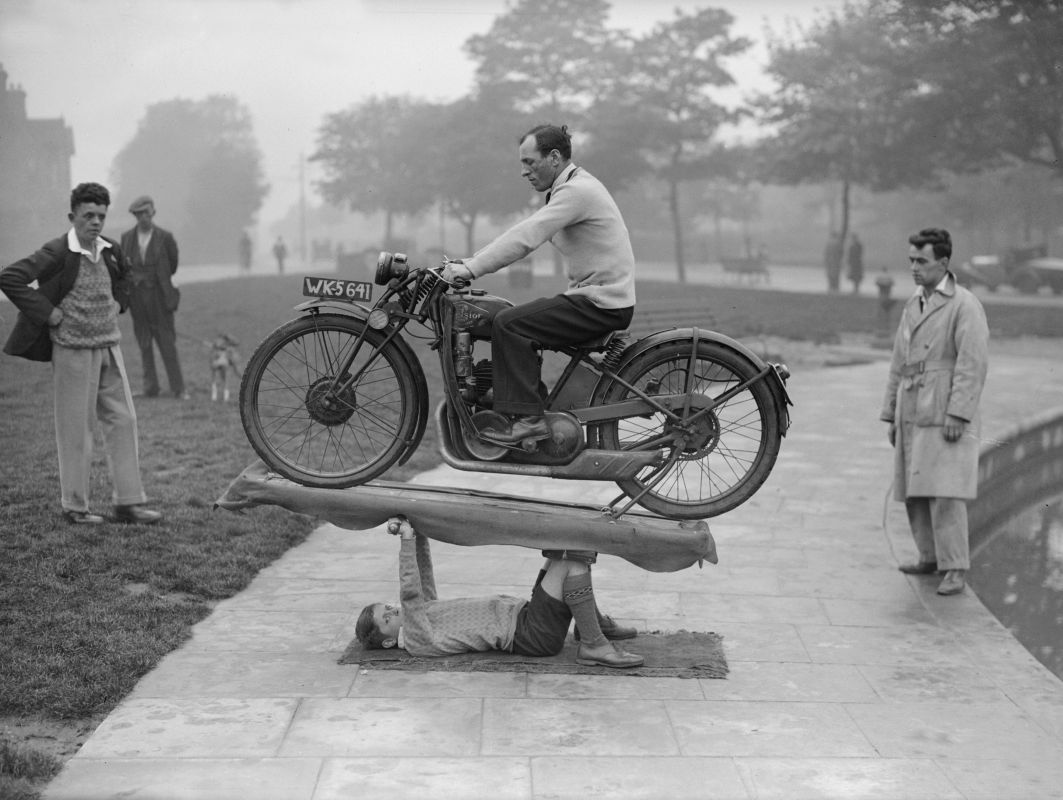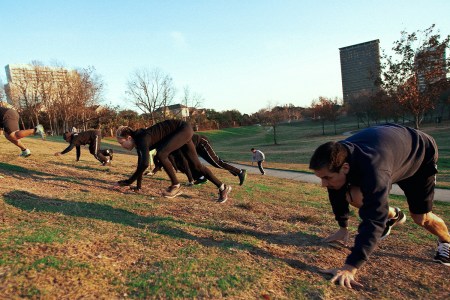For how much significance casual weight-lifters typically place on the bench press, you might be surprised that the prototypical movement wasn’t invented until 1898, and the weight bench wasn’t invented until the middle of the 1940s.
And yet: we’ve all seen enough photos and images of old-time strongmen or bodybuilders to know that virtually all of them had sculpted chests.
So, prior to the 1940s, how did they do it? And is it possible for you to borrow their 19th-century secrets? Absolutely! But to build a bigger chest, you’re going to need an open mind. Here’s your guide to the preferred equipment and exercises of yesteryear:
How to Perform the Ultimate Animal Kingdom Workout
Move like a frog, leopard or kangaroo with this 12-move guideThe Banded Push-Up
Eugen Sandow, who is widely credited with popularizing bodybuilding, and whose likeness is immortalized in the Sandow (the trophy presented to winners of the Mr. Olympia competition) was a big fan of the push-up. Sandow recommended the move in some of his earliest writings on muscular development.
He specifically advised followers of his training routine to begin with one set of three push-ups, then increase their output by one push-up rep every three days. In addition, Sandow encouraged the use of rubber resistance bands to add to the intensity of the push-ups. This gave Sandow a replicable way to exceed the resistance supplied by ordinary push-ups — which amounts to approximately 64% of one’s body weight — and magnify the tension.
The Bodyweight Dip
The bodyweight dip is essentially the most challenging variation of a push-up, obligating a trainee to lift closer to 95% of their own weight (only negating the weight extending from one’s fingers to their elbow joints).
The move is a derivation from early gymnastics, where apparatuses like the high bar, rings and parallel bar encouraged the first waves of gym enthusiasts to adopt pull-ups, chin-ups and dipping-equivalent movements into their repertoires. Over time, machines and other substitutionary equipment were invented, which captured the essence of these movements and make them easier.
Fortunately for you, most commercial gyms now come equipped with at least one bodyweight dip station. A makeshift dip stand could be erected in your own home, between any two parallel bars of equal height that sit far enough off the ground.
How to Get Into “Himalayan Shape”
A training blueprint for those with zero plans of actually climbing EverestThe First Chest Machines
To be clear, weighted machines aren’t entirely new: engineers of the 19th century started producing machinery capable of boosting muscle size as they realized how challenging bodyweight movements could be. The first iterations were a series of different pulley-based machines, which very similar in concept and design to the cable stations of modern-day gyms.
In a May 7, 1889 article from The Topeka State Journal, the writer describes the value of the most resistance-intensive pulleys of all — “the giant pulleys” — and their extreme usefulness in crafting chest muscles.
“If the front of the chest is full and the back or side deficient, the pupil is set to work on the giant pulley,” stated the writer. “To build up the side walls he stands with his back to the pulley-box and the left heel resting against it; the handle is grasped in the right hand if the right side of the chest is lacking development. To exercise the left side the same process is gone through with the handle grasped in the left hand.”
The illustration accompanying this description exhibited a man stepping forward and away from the machine while holding a handle anchored to that same device. He appears to be completing what could generously be described as a lunging single-arm chest press before returning to his starting position.
Another device created for chest development was based upon the reliable method of parallel bar dips, and it was fittingly referred to as the “sliding parallel bars.” Users of the machine grasped a set of bars as if they were going to perform parallel bar dips, but instead of elevating themselves off the ground, they would instead press downward against resistance supplied by a cable connected to weights. Nowadays, the machine would probably be regarded as a prototype for the seated dip machines available on most gym floors.
The Classic Home Chest Developers
In April of 1895, The Pittsburgh Press actually recorded the occasion of Eugen Sandow meeting with amateur bodybuilder E.S. Hulsman. Sandow was quite taken with the man’s physique. Rather than citing any classic weightlifting or gymnastic training for the quality of his upper body, Hulsman attributed his development to his use of weighted Indian Clubs and a rubber exerciser of his own design, which he sought to patent. Suspiciously soon after this encounter, Sandow began to advertise and sell thick, self-branded rubber bands as “chest expanders.”
Very quickly, the burgeoning home fitness market was flooded with chest expanders, chest exercisers and chest developers created from either steel springs, or rubber and elastic bands. Despite their names and designs, nearly all of the chest-building devices required their users to anchor them to a door frame or some other stationary object. In that way, the handles could be pushed forward in a chest-pressing motion that captured resistance from behind the body and extended it toward the front.
Among the most recognizable of these devices is the traditional chest expander, familiar as a set of three steel springs, connected at each end by a pair of wooden or metal handles. While the most basic movements prescribed for use with the chest expander actually increased the size of the user’s shoulders (and back) far more easily, it could be anchored at one end to objects like door handles, in order to be pressed outward to maximize the tension on the chest — one side at a time.
In fact, years before he began peddling his “Dynamic Tension” workout as the development of his physique, famous strongman and bodybuilder Charles Atlas disclosed to the press that it was actually his job serving as a model for steel workout springs (a position that required him to stand in a store window and train with chest expanders all day long) that helped him build muscle
If you’d like to take a modern version of this precursor to rubber-band training for a whirl, new iterations of it can still be purchased in a less expensive, rubberized form to this very day.
Pressing Forward
Clearly, there is no shortage of methods that you can use to provide yourself with a body on par with some of the classic greats of fitness. Even without the bench press as a training tool, these fitness legends all had chests that would still pass the double-take test at a gym or at the beach more than a century later.
If you lack access to a weight bench, or you simply have no desire to hold hundreds of pounds precariously above your neck and chest and pray that you can get it successfully re-racked before a fatal mishap ensues, you can still achieve your dream of pectoral perfection without fighting off the hordes of your fellow gym attendees, knowing that there are other pathways to pectoral perfection.
The Charge will help you move better, think clearer and stay in the game longer. Subscribe to our wellness newsletter today.



























